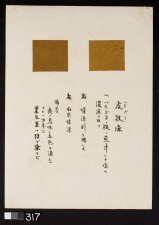Difference between revisions of "Itadori (Japanese knotweed) - right (317 R)"
Jump to navigation
Jump to search
(username removed) |
(username removed) |
||
| Line 5: | Line 5: | ||
| 317 | | 317 | ||
|- | |- | ||
| − | ! scope="row"| | + | ! scope="row"|Uemura number / title |
| − | | | + | | ; "Haze-some 25" |
|- | |- | ||
! scope="row"|Folder location | ! scope="row"|Folder location | ||
| Line 41: | Line 41: | ||
| - | | - | ||
|- | |- | ||
| − | ! scope="row"| | + | ! scope="row"|Uemura's notes |
| The concentration of the dye bath was high. The resultant color did not become red. Dyeing with its leaves and stems would hardly produce any color. | | The concentration of the dye bath was high. The resultant color did not become red. Dyeing with its leaves and stems would hardly produce any color. | ||
|- | |- | ||
| − | ! scope="row"| | + | ! scope="row"|Uemura's date |
| - | | - | ||
|} | |} | ||
| − | [[Category: | + | [[Category:Uemura dye archive]] |
Revision as of 07:20, 24 July 2013
| Museum number | 317 |
|---|---|
| Uemura number / title | ; "Haze-some 25" |
| Folder location | 4th shelf |
| Sample location | right (317 R) |
| Fiber type | silk |
| Color | brown (slightly yellowish) |
| Dyestuff (Japanese common name) | 虎杖 : Itadori |
| Dyestuff (botanical name) | Fallopia japonica (Houtt.) Ronse Decr. var. japonica (Polygonum cuspidatum Siebold et Zucc.) |
| Plant part | root / dried (?) |
| Dyestuff extraction | boiled in water |
| Auxiliary agent in dye bath | - |
| Mordant | - |
| Other auxiliary agent | - |
| Uemura's notes | The concentration of the dye bath was high. The resultant color did not become red. Dyeing with its leaves and stems would hardly produce any color. |
| Uemura's date | - |
